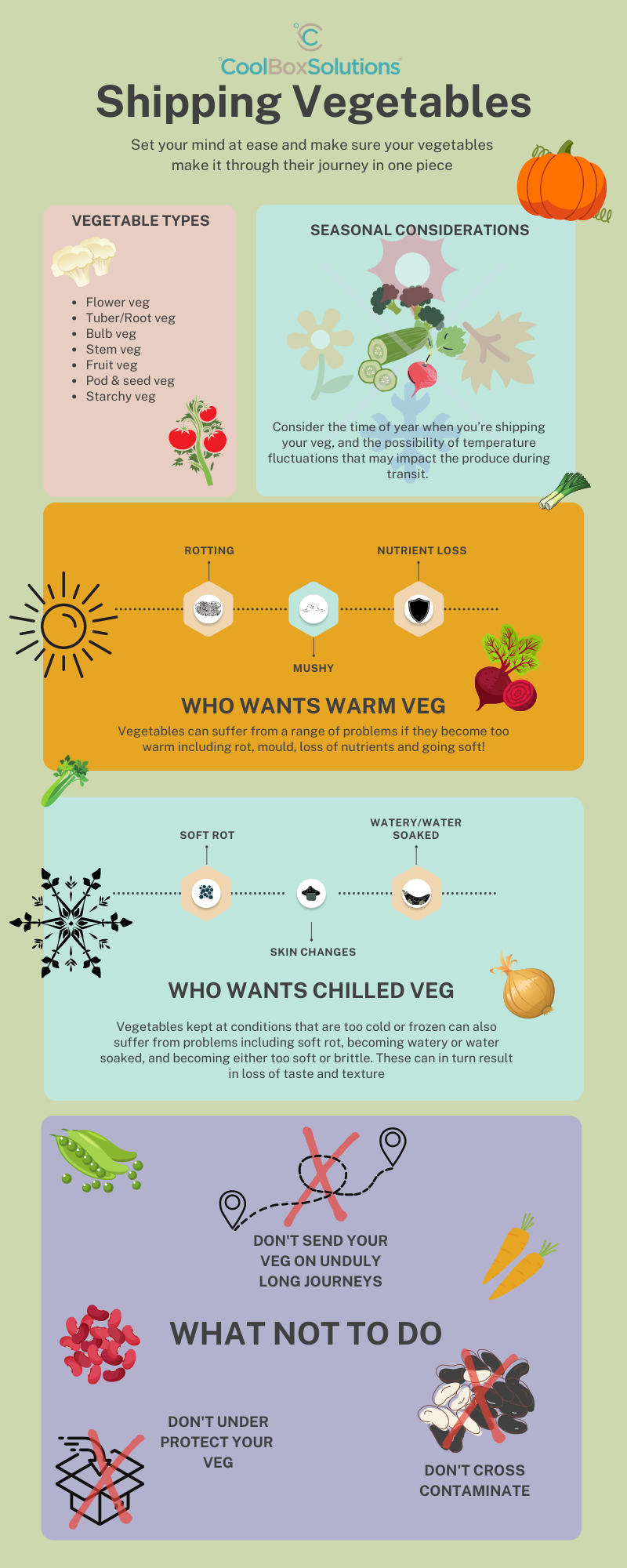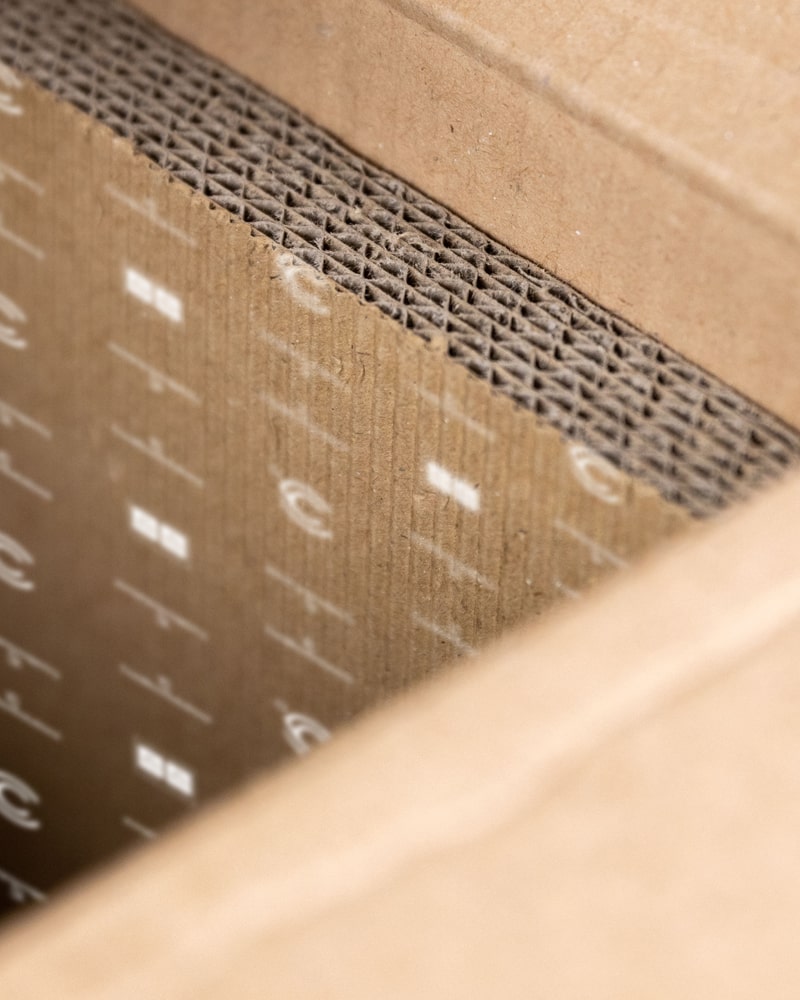
The latest in our guide to shipping different foodstuffs will definitely leaf you into un-chard-ed territories. No longer will your beans be green when they see their veggie mates arriving in better condition than they are, or your corn be playing it by ear as to whether it reaches its destination safely; this a-maizeing guide to shipping vegetables will help you to romaine calm and give you a rock salad foundation to keeping both your customers and vegetables happy. Lettuce guide you through every stage of your veggie shipping process to make sure they arrive in tip-top condition!
Different types of veg
Vegetables as a food group fall into 7 different classifications; these are:
- Flower veg – cauliflower, broccoli, globe artichokes
- Tuber/root veg – carrots, radishes, beets
- Bulb veg – onions, leeks, garlic
- Stem veg – celery, asparagus, bamboo shoots
- Fruit veg – tomatoes, cucumbers, pumpkins
- Pod & seed veg – peas, beans, lentils
- Starchy veg – sweet potatoes, white potatoes, corn (bear in mind that these are so called “starchy” due to their composition and not the part of the veg that you eat). A lot of the vegetables in this group can also be classified in other groups; for example, potatoes are both starchy and tubers.
- Leafy crops – kale, cabbage, Chinese leaves
These different types of vegetable have different requirements when it comes to temperature controlled shipping.
Tuber vegetables
Tuber vegetables have the same tolerance levels as Flower vegetables and are at their freshest if transported at consistent temperatures between 0°C to +1°C. Again, there is a little room for increased temp during loading or unloading but ideally they need to be kept between 0°C to +1°C.
Bulb vegetables
Bulb vegetables prefer things to be a little cooler during transit and a consistent temperature of 0°C is ideal for the majority of vegetables in this category. Some, like garlic, can be kept a little lower but no lower than -1°C.
Flower vegetables
Flower type vegetables such as cauliflower, broccoli and artichokes have an optimum transport/carrying temperature between 0°C to +1°C. Whilst there is room for a slight temperature increase whilst loading these vegetables (max 2 °C), they should be keep consistently between 0°C to +1°C if possible for the majority of the journey.
Pod & Seed vegetables
Pod and seed vegetables are very much like flower, stem, tuber or bulb vegetables and should be carried at temps ranging between 0°C-2°C. That being said, certain types of pod or seed veg like snap or French beans can be carried at temps between 5°C-7°C, although broad beans prefer lower temps. As with other types of veg, it is very important to check your individual vegetable type’s specific preferences before packaging for transport.
Stem vegetables
Stem vegetables are more like Flower and Tuber veg types and like temps to be between 0°C to +1°C. Some, like asparagus, are a little more tolerant and can take an extra degree or so, but no more than +2°C at most.
Fruit vegetables
Flower vegetables are a lot more tolerant of heat than any other type; the optimum carrying temp during transport varies from around 10°C – 15°C – this is quite a large range of maximum temp so it’s best to check the individual vegetable’s tolerances before packing for shipping. Tomatoes, for example, need different profiles depending on the stage they’re at in their lifecycle and can tolerate a max. of 15°C if they’re mature green, 12°C if turning and 10°C if fully ripened.
Starchy vegetables
Starchy vegetables have a large range of temperature profiles depending on the veg in question. Some types of white potato, for example, like to be transported at no more than 10°C but some types need to be kept at no hotter than 4°C. Sweet potatoes on the other hand can be carried at up to +15°C.
Leafy crops
As with many of the types above, leafy crop vegetables should be kept between 0 °C to +2°C and this is very important, as leafy veggies will suffer quickly if they stray outside of these temps for any significant amount of time. You will see them wilt and turn yellow if they become too warm and may suffer a water related breakdown if they become too cold. As with any specific vegetable, there are some in this group that can cope better than others, so best to check each type before you pack them.
As with all types of fresh produce, it is extremely important for anyone shipping any type of vegetable to make sure the produce is kept at continual temperature controlled conditions through the entire transport process.
What happens if vegetables become too warm?
Unlike chilled produce like cheese or milk, vegetables do not tend to become unpalatable if they become too warm during transit or storage. After all, we do cook a lot of our veg before we eat it, so veg that has been exposed to warmer temperatures than desired during transit should, in the main, still be safe to eat.
That being said, there are still ramifications if all types of vegetables is transported at warmer temperatures than recommended, such as:
- Loss of vital vitamins and nutrients including Vitamin C, Vitamin B and folate
- The risk of rotting, cavity spots, mould growth, staining, bruising or cracking
- Some vegetables may also become soft when they are kept at warmer temperatures
- The risk of sprouting during transit for vegetables like potatoes or onions
What happens if vegetables become too cold?
We also have to think about the problems that could occur if vegetables are exposed to conditions that are too cool. Whilst it is safe to freeze most types of veg, this tends to happen just once before it is then cooked/eaten, so we want to avoid it during the transport process (unlike the veg is to be sold as frozen, in which case it would need a frozen shipping profile from the start).
If vegetables become too cold or frozen during transit, problems that could occur through chilling injuries include:
- Soft rot, which is where the vegetable starts to decay
- Freezing, then defrosting, which can lead to water loss and the vegetable becoming too soft or disintegrating
- Change of skin colour
- Brown spots
- Brittle composition
- Increased susceptibility to bacterial decay
Seasonal considerations
You should consider the time of year when you’re preparing to ship any type of vegetable, and the possibility of temperature fluctuations that may have an impact during transit. Even if you’re using a temperature controlled packaging solution, you need to be aware of how many ice packs are needed in conjunction with the outer packaging system to keep the contents inside at a constant chilled temperature, and also how effective the packaging itself is going to be.
Different materials also have different insulating properties, so this is certainly something to find out before you commit to any one system.
One other seasonal aspect to consider is the risk of wet conditions and how the outer materials you’re using will respond if they become wet. Will they be able to still protect the goods inside, and what will happen if they don’t?
Packaging in bulk or individually
It’s unlikely you will be shipping individual vegetable items, although there are of course some situations in which this may happen such as for individual meal kit recipes where only one or two vegetable items may be required. A lot of vegetables are shipping together in bulk, and the packaging needs to reflect the needs of the individual type of veg inside the box, even if multiple boxed will then be shipped inside a larger container.
What not to do
We’ve talked about what you should do when shipping vegetables, but what about what not to do?
- Don’t think that because a vegetable looks tough, it won’t get damaged during transit. Even the hardiest of vegetable like potatoes or parsnips should be properly protected from accidental damage.
- Ensure there are no cross contamination risks. You definitely don’t want to take any risks with different vegetable types being together if there is a chance one may spoil and possibly leak onto the other – for example, a tomato, which is a lot more delicate than a potato, needs to be packaged separately and with different temperatures.
- Don’t send your vegetables on an unduly long journey – ideally you want them to get from A to B within 48 hours at the most, so it’s important to look for a courier solution that can offer this timeframe. Just because they are more tolerant to warmth than other types of food group doesn’t mean they should tolerant longer journeys, which will also lead to increased damage or loss risks.
In conclusion, if you want your vegetables arrive at their final destination in the same shape they left the patch in, you need to make sure you go above the kale of duty and provide a rock salad shipping solution in which they won’t be melon-ccoli and won’t need to be tossed out by the end of the journey!


